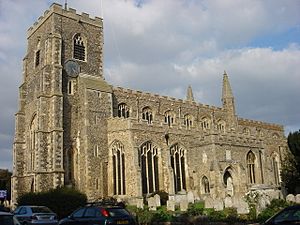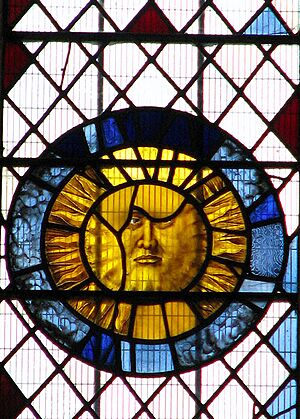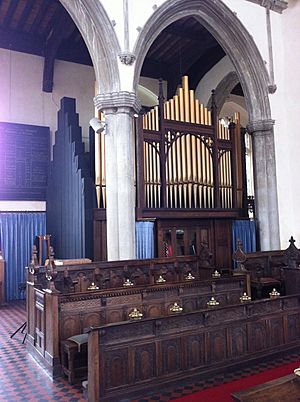St Peter and St Paul's Church, Clare facts for kids
Quick facts for kids St Peter and St Paul's Church, Clare |
|
|---|---|

St Peter and St Paul's Church, Clare
|
|
| 52°4′43.88″N 0°34′51.44″E / 52.0788556°N 0.5809556°E | |
| OS grid reference | TL 76964 45461 |
| Location | Clare, Suffolk |
| Country | England |
| Denomination | Church of England |
| Churchmanship | Broad Church |
| Membership | 99 |
| Weekly attendance | 40-90 |
| Website | https://stpeterandstpaulclare.uk/ |
| History | |
| Dedication | St Peter and St Paul |
| Architecture | |
| Heritage designation | Grade I listed |
| Administration | |
| Parish | Clare |
| Deanery | Sudbury |
| Archdeaconry | Suffolk |
| Diocese | Diocese of St Edmundsbury and Ipswich |
St Peter and St Paul's Church in Clare, Suffolk is a very old and important church. It is one of the biggest churches in East Anglia. This church is so special that it is listed as a Grade I listed building. This means it is a building of exceptional interest.
Contents
A Look Back in Time
The church's history goes back a long way. Records show priests here as early as 1307. The tall tower at the west end was built in the 1200s. Most of the church you see today was built in the 1300s and early 1400s.
The church has been repaired and updated many times. For example, the main part of the church, called the nave, was fixed in the 1440s. The chancel, where the altar is, was worked on in 1617. The tower was repaired again in the late 1800s.
Special Features Inside
This church has some really cool old features. There's a special stand for reading, called a lectern, from the late 1400s. It's shaped like an eagle with three dogs as its feet! It might have even been used as a collection box. Money could be put in the eagle's beak and would come out its tail.
You can also see two fancy private seating areas, called pews. One has symbols of King Henry VIII and his first wife, Catherine of Aragon. The other is a grand Stuart-era pew with unique carvings. In the chancel, there are rare choir stalls from the Jacobean period.
Outside, above the south porch, there's a sundial. It has a motto that says: 'Go about your business'. This is a reminder to be busy with good things, like St Paul advised. Look closely around the doorway, and you might spot ten carved faces of the Green Man. This is an ancient nature symbol found in many old churches.
The Puritan Visit
One of the biggest events in the church's history happened in 1643. A man named William Dowsing visited. He was sent by the Parliament during the English Civil War. His job was to remove or destroy anything in churches that was considered "superstitious."
Dowsing was very strict about this. He wrote in his journal about his visit to Clare. On January 6, 1644, he ordered the destruction of many images. He said they broke down "1000 pictures" and he personally broke down 200. This included images of God, Christ, and the Holy Spirit. Carvings of the Twelve Apostles and cherubs were also ordered to be taken down from the roof.
He even wanted the sun and moon images in the East window removed. You can still see bullet holes in the roof, which might show how some of the destruction was done. Other damage was caused by arrows, stones, poles, and whitewash. Luckily, the sun and moon images still survive today!

Victorian Era Changes
Like many churches in England, St Peter and St Paul's was changed during the Victorian era. It was first repaired between 1834 and 1836. A gallery was also added inside. More work was done from 1877 to 1883, based on plans by architect James Piers St Aubyn. Later, in 1898, Detmar Blow helped repair the tower.
How the Church is Run
St Peter and St Paul's Church is part of a group of churches called the Stour Valley Benefice. This group also includes St Mary's Church in Poslingford.
What You Can See Today
The Organ
The church has a beautiful organ. In the 1700s, it was at the back of the church. But in 1864, it was moved to its current spot. A new organ was brought in in 1888. It was originally built in 1847 for another church in London.
In 1977, a different organ was put in. It came from St Peter's Church in Ipswich. This organ was placed there to remember Clare Wayman, who lived from 1892 to 1976.
The Bells
The church has eight bells that can be rung. The heaviest of these bells weighs about 28 hundredweight (which is a lot!). This makes it the heaviest bell in any set of eight bells in Suffolk.
One bell, the 7th bell, is very old. It was likely made around 1410. It has a special message in Latin that means "Holy Trinity conserve this bell." The sixth bell is from 1579. It is the largest bell made by its creator, John Dier, that still exists.
In 1781, two more bells were added, making a total of eight. The bells have been repaired and recast over the years by different bell makers.
The Gotch
An interesting item in the church is called "the gotch." It's a large beer jug that was given to the bell ringers in 1729 by the vicar, Matthew Bell. It's almost 20 inches (50 cm) tall and can hold a lot of liquid!
The jug has a clever saying on it in Latin: campana sonant canore. This means "the bells ring in harmony." The bell and crown symbols on the jug refer to the Crown Hotel, which was owned by the vicar's family.
Visiting the Church
St Peter and St Paul's Church is open every day for visitors. There are groups that help support the church. The Friends of Clare Church raise money and hold events. The Society for Music in Clare Church organizes concerts throughout the year. There's also a Mothers' Union group and a Flower Guild that helps decorate the church.
The church choir sings at the main Sunday services. You can also find a shop and a bookstall inside the church. Parking is available nearby in Clare. The closest car park is at Clare Country Park, which is about a five-minute walk up a gentle hill.
Images for kids
-
The sun - a fragment of medieval stained glass saved from William Dowsing




